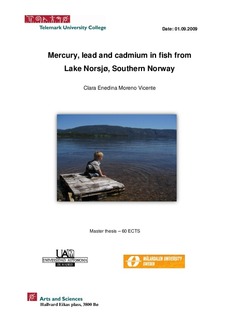Mercury, lead and cadmium in fish from Lake Norsjø, Southern Norway
Master thesis
Published version
Permanent lenke
http://hdl.handle.net/11250/2438888Utgivelsesdato
2009-09-01Metadata
Vis full innførselSamlinger
Sammendrag
Concentrations of mercury (Hg), cadmium (Cd) and lead (Pb) have been investigated in whitefish (Coregonus lavaretus, n = 41), European smelt (Osmerus eperlanus, n = 29), Arctic char (Salvelinus alpinus, n = 27), perch (Perca fluviatilis, n = 26), brown trout (Salmo trutta, n = 22), Atlantic salmon (Salmo salar, n = 14), northern pike (Esox lucius, n = 11), tench (Tinca tinca, n = 4) and crucian carp (Carassius carassius, n = 2), in Lake Norsjø, southern Norway. In addition, the stable isotope ratios 15N and 13C have been analysed to reveal variations in trophic position and carbon source, both within and between fish species. The concentrations of Cd and Pb were far below the consumption limits in Norway, i.e. 0,2 μg Cd/L; 1 μg Pb/L). Only 5,6 % of the analyzed individuals had Pb-concentrations > the detection limit for Pb (0,1 mg Pb/kg ww), while none of the individuals exceeded the detection limits for Cd (0,005 mg Cd/kg ww). The Hg levels varied within and between the fish species. Totally 9 fish had Hg-concentrations above the consumption limit of 0,5 μg Hg/L, 5 pikes, 2 Arctic char, 1 brown trout and 1 European smelt. The highest concentration, 1,44 mg Hg/kg ww, was both measured in a brown trout and a northern pike. The δ15N and δ13C values varied from 7,2 ‰ to 13,6 ‰ and -20,2 ‰ to -33,5 ‰ respectively. The results on δ15N indicate a food web consisting of 4 consumer levels. The δ13C signatures indicate that Arctic char, European smelt and sub-populations of whitefish primarily feed in the pelagic zone (13C between -28 and -34), while the 13C in perch, brown trout and the other sub-population of whitefish had heavier 13C signatures, indicating fish feeding in the littoral zone of the lake. All fish species (except Atlantic salmon) exhibit significant correlations (p < 0,05) between Hg and age, weight and length. Only adult individuals of Atlantic salmon, returned from the sea to River Skienselva for spawning, were incorporated in the study. Low concentrations and minor variations in the Hg-levels (0,07 – 0,14 mg Hg/kg ww) in this marine derived individuals, are the main reasons for no correlation between Hg and age, weight and length for this species. Within each species, no significant correlations were found between Hg and 15N, but a weak but significant (r2 = 0,074, p < 0,001) positive linear relationship was found when plotting all the fish species together, indicating biomagnification along the food web. The high15N signature in the dwarf population of Arctic char is likely a consequence of low condition factor, as transamination and deamination normally occur during starvation. These processes imply isotope fractionation of nitrogen and consequently a heavier 15N signature.
